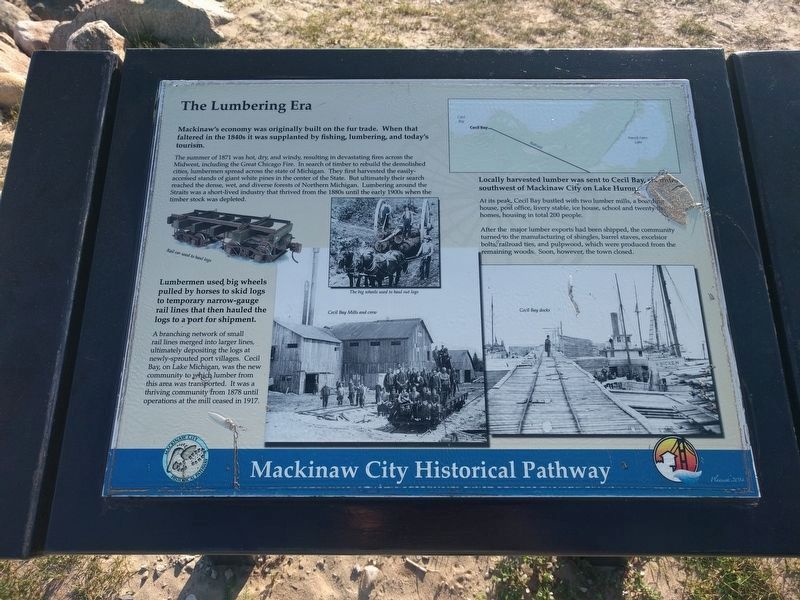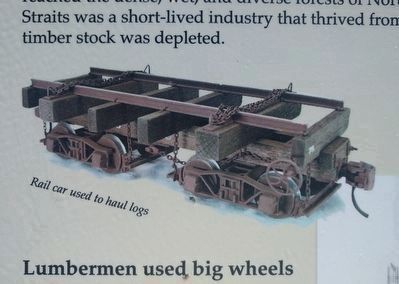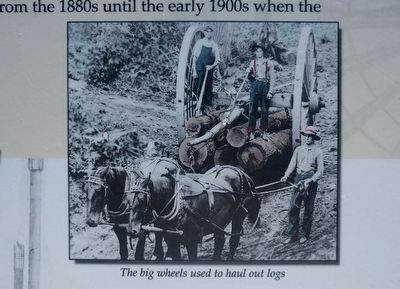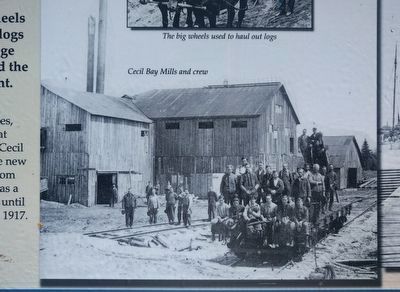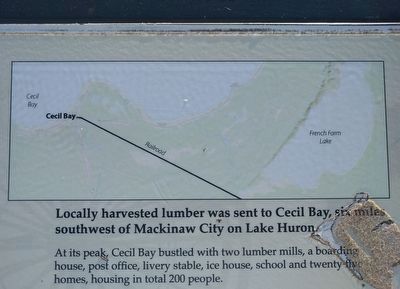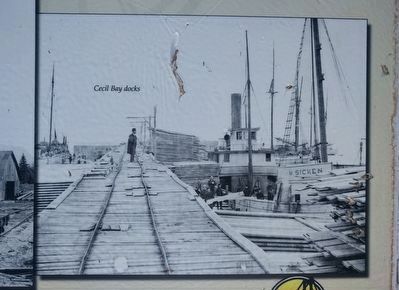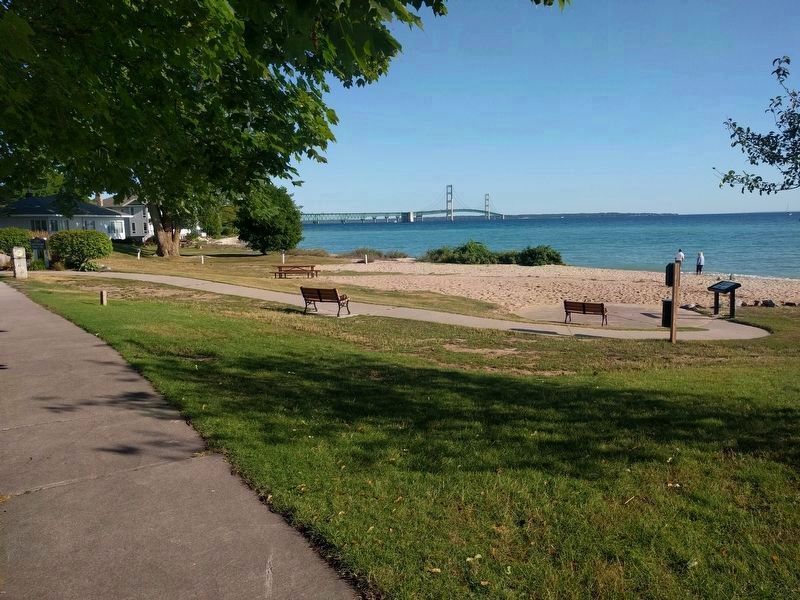Mackinaw City in Cheboygan County, Michigan — The American Midwest (Great Lakes)
The Lumbering Era
Mackinaw City Historical Pathway
Mackinaw's economy was originally built on the fur trade. When that faltered in the 1840s it was supplanted by fising, lumbering, and today's tourism.
The summer of 1871 was hot, dry, and windy, resulting in devastating fires across the Midwest, including the Great Chicago Fire. In search of timber to rebuild the demolished cities, lumbermen spread across the state of Michigan. They first harvested the easily-accessed stands of giant white pines in the center of the State. But ultimately their search reached the dense, wet, and diverse forests of Northern Michigan. Lumbering around the Straits was a short-lived industry that thrived from the 1880s until the early 1900s when the timber stock was depleted.
Lumbermen used big wheels pulled by horses to skid logs to temporary narrow-gauge rail lines that then hauled the logs to a port for shipment.
A branching network of small rail lines merged into larger lines, ultimately depositing the logs at newly-sprouted port villages. Cecil Bay, on Lake Michigan, was the new community to which lumber from this area was transported. It was a thriving community from 1878 until operations at the mill ceased in 1917.
Locally harvested lumber was sent to Cecil Bay, six miles southwest of Mackinaw City on Lake Huron [sic].
At its peak, Cecil Bay bustled with two lumber mills, a boarding house, post office, livery stable, ice house, school and twenty-five homes, housing in total 200 people.
After the major lumber exports had been shipped, the community turned to the manufacturing of shingles, barrel staves, excelsior bolts, railroad ties, and pulpwood, which were produced from the remaining woods. Soon, however, the town closed. (Marker Number 20.)
Topics. This historical marker is listed in these topic lists: Disasters • Industry & Commerce • Railroads & Streetcars. A significant historical year for this entry is 1871.
Location. 45° 47.084′ N, 84° 43.49′ W. Marker is in Mackinaw City, Michigan, in Cheboygan County. Marker is at the intersection of North Huron Avenue and East Sinclair Street, on the right when traveling north on North Huron Avenue. Marker is in Gary R. Williams Memorial Park. Touch for map. Marker is in this post office area: Mackinaw City MI 49701, United States of America. Touch for directions.
Other nearby markers. At least 8 other markers are within walking distance of this marker. Anchors and their retrieval / Capstan for pulling up the anchor (about 500 feet away, measured in a direct line); Chief Wawatam (about 500 feet away); a different marker also named Chief Wawatam (about 500 feet away); Marine & Weather Reporter (about 500 feet away); A Bridge for Mackinac (about 600 feet away); Our weather (about 600 feet away); John L. (Jack) Staffan • Chief Wawatam (about 600 feet away); Mackinaw Woman's Club, Inc. (about 600 feet away). Touch for a list and map of all markers in Mackinaw City.
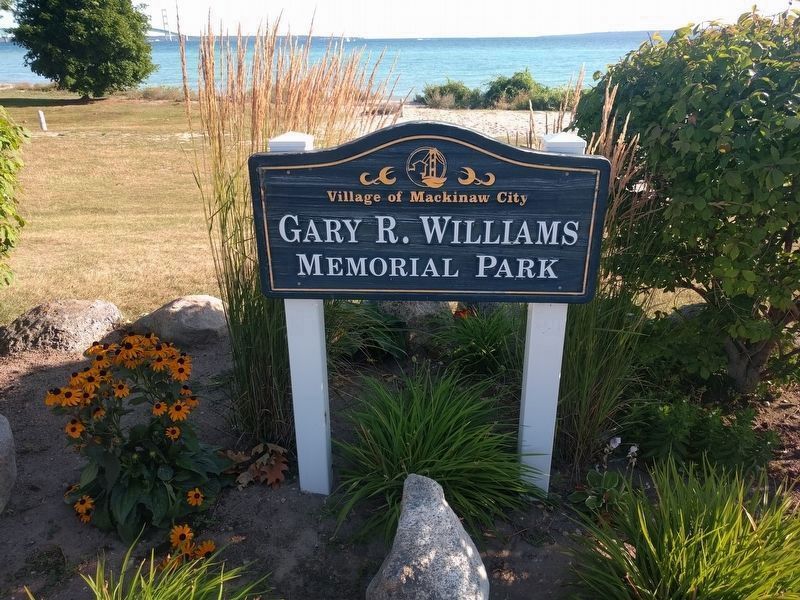
Photographed By Joel Seewald, August 19, 2019
8. Gary R. Williams Memorial Park sign
The marker may not be visible from the street while driving because of the slope down to the beach, but the park sign can be seen from North Huron Avenue, the north end of Langlande Steet, and the east end of East Sinclair Street.
Credits. This page was last revised on October 11, 2019. It was originally submitted on October 11, 2019, by Joel Seewald of Madison Heights, Michigan. This page has been viewed 152 times since then and 13 times this year. Photos: 1, 2, 3, 4, 5, 6, 7, 8. submitted on October 11, 2019, by Joel Seewald of Madison Heights, Michigan.
